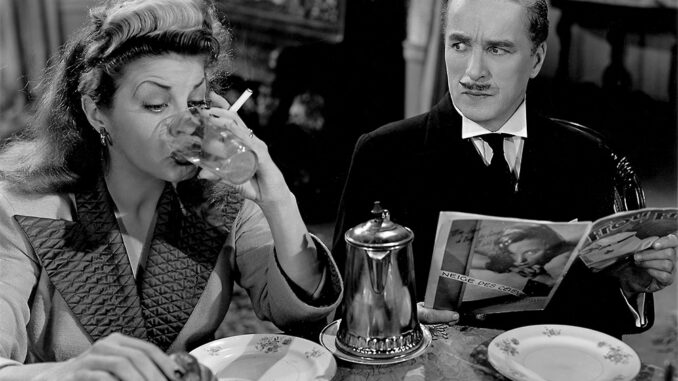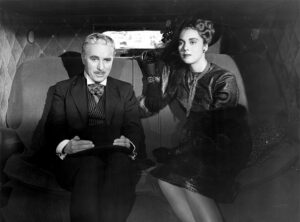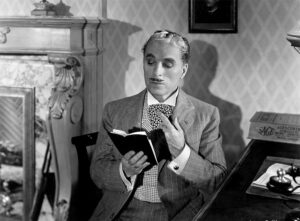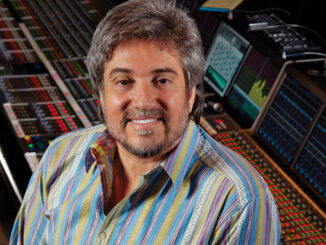
by Edward Landler
Seventy years ago, on April 11, 1947, Charles Chaplin — one of the central figures of world cinema and as influential to the art of moviemaking as to the establishment of the Hollywood film industry — premiered his latest film, Monsieur Verdoux (subtitled A Comedy of Murders) at the Broadway Theatre in New York City and at the Academy Award Theatre in Los Angeles.

Charles Chaplin/Photofest
Six years earlier, in The Great Dictator (1941), Chaplin had used his universally recognized and beloved Tramp character in the guise of a Jewish barber, and his resemblance to Adolf Hitler, to satirize authoritarianism. In Verdoux, set during the Depression in pre-World War II France, the filmmaker broadened his scope to question how the drive for success in business undermines the personal aspirations for love and a home.
Leaving his familiar persona behind, the movie’s title character is everything the Tramp always wanted to be: Verdoux is elegant, educated and genteel — a hard-working independent small businessman supporting an adored wife and child. But his business? Taking on a host of different identities throughout France to seduce, marry and murder women for their money.
In an interview published shortly before the film’s premiere, Chaplin noted, “Von Clausewitz said that war is the logical extension of diplomacy; Monsieur Verdoux feels that murder is the logical extension of business. He should express the feeling of the times we live in…society with all its attending upheavals, wars and depressions brings out the latent evil tendencies in weak characters… He is frustrated, bitter and, at the end, pessimistic. But he is never morbid.”
Indeed, as Verdoux states in the film, “Business is a ruthless business.”
Coming out soon after the war’s end, the movie only played 2,075 dates in the US, earning a mere $325,000 over two years before Chaplin withdrew it from circulation. This despite being named the Best Film of the Year by the National Board of Review and nominated for the Best Original Screenplay Oscar (which it lost to the Cary Grant/Shirley Temple comedy, The Bachelor and the Bobby-Soxer, written by Sidney Sheldon).
American moviegoers, though, were not ready for Chaplin’s black comedy at a time when the House Un-American Activities Committee (HUAC) was grabbing headlines to investigate Communist influence in the movie industry. The filmmaker’s progressive social leanings became a critical factor in his eventual exile from the country that had been his home for over 30 years.
Outside the US, where the war’s violence had actually played out, Monsieur Verdoux grossed over $1.5 million, with over a half-million tickets sold in Paris alone. Denmark gave the movie its Bodil Award for Best American Feature, and Japan’s two most prestigious film awards — the Kinema Junpo Awards and the Blue Ribbon Awards — both honored it as Best Foreign Language Film when it was released there in 1953. When the film came out in the United Kingdom, novelist Evelyn Waugh said, “The success or failure of Monsieur Verdoux in England will be a test, not of Charlie, but of us.”

Charles Chaplin/Photofest
The making of the film was sparked by a visit to Chaplin by Orson Welles, who was thinking of making a series of dramatized documentaries after Citizen Kane (1941). The first would be about the notorious French Bluebeard, Henri Désiré Landru, who was guillotined in February 1922 for the murder of 10 women and the son of one of them. Welles asked Chaplin to portray the serial killer and perhaps help write the script.
Tempted by the challenge of such a role, but wary of collaborating on the writing, Chaplin refused. But, as he relates in his autobiography, he called Welles a few days later and told him that the proposal had given him the idea for “a wonderful comedy,” a fiction not about Landru himself. Although the factual story was in the public domain, the movie pioneer was willing to give the young filmmaker $5,000 for suggesting the idea.
Welles said he would accept only if he received a screen credit reading, “Based on an idea by Orson Welles.” A formal agreement was signed on July 24, 1941. Welles then produced his adaptation of Booth Tarkington’s The Magnificent Ambersons (1942) while Chaplin wrote a screen adaptation of Paul Vincent Carroll’s 1937 play of spiritual faith, Shadow and Substance. After shelving this project, the comedian began working on the Verdoux script late in 1942.
Over the following three years, while crafting the screenplay, the events in his personal life seriously affected Americans’ view of Chaplin. On June 16, 1943, the three-times divorced, 54-year old comedian married 18-year old Oona O’Neill, the estranged daughter of America’s leading playwright, Eugene O’Neill. Chaplin had met his bride seven months earlier when he auditioned her for the central role in the aborted Shadow and Substance.
The marriage produced eight children and lasted until the artist’s death in 1977, but the press sharpened its criticism because of a paternity suit filed against him by actress Joan Barry two weeks before his low-profile wedding. Chaplin had screen-tested Barry also for the Shadow role and admitted to their friendship, but as she had had affairs with others — including oilman J. Paul Getty — the filmmaker had distanced himself from her.
Despite blood tests proving he was not the father of Barry’s child, and a 1944 acquittal on Mann Act charges, the paternity trial jury in 1945 voted 11 to 1 against Chaplin and ordered him to pay child support. With the war drawing to a close, public opinion was also influenced by the growing political censure of the comedian’s speaking at wartime rallies in support of the US’ Soviet allies against Nazi Germany.
Through it all, the filmmaker continued work on Verdoux. He completed the script in February 1946 and sent it immediately to Joseph Breen of the Production Code Administration (PCA) for approval. After a series of letters and a meeting with Breen over the PCA’s detailed objections to dialogue about illicit sex, the mocking of religion and the equating of war with murder, Chaplin agreed to a seven-page list of minor changes (like changing “come to bed” to “get to bed”).
Pre-production had already begun at the Chaplin Studios, which the moviemaker had built for himself in 1917 (now the Jim Henson Company Lot), with the producer/director/writer/star/composer virtually micro-managing the entire project. The film’s director of photography, Roland Totheroh, ASC, had begun his career shooting Western shorts before working with Chaplin in 1915, and then almost exclusively for the next 32 years.
Budgeted for $1.5 million, the shoot was scheduled for 61 days, almost entirely at the studio, shooting six days a week from May 31 to August 13, 1946. Production went 19 days over schedule, finishing on September 5 with the budget approaching $2 million. There were no retakes, but additional shots and inserts were done by a second unit through March 4, 1947.
Cast and crew were sworn to secrecy about the production until its release. Verdoux’s complex character and his subtle shifts from hard businessman to loving family man required that Chaplin cast an actor opposite him to draw the film’s broadest laughs. For the role of Annabella Bonheur, the wife who unwittingly evades all his efforts to kill her, he chose “The Big Mouth” comic, Martha Raye.
Raised performing in vaudeville with her parents, Raye started making movies in 1936. When her agent told her that Chaplin wanted to give her second billing in his next picture, she thought it was a joke: “To a comedienne, that’s like God calling you.”
For the movie’s takeoff on Theodore Dreiser’s novel An American Tragedy (1925), three days in August were spent on Lake Malibu shooting Verdoux’s attempt to murder Anabella in a rowboat. In contrast, the climactic courtroom scene was shot in one day; Chaplin performed his speech 10 times and printed six takes for editing.
On September 9, he began cutting with editor Willard Nico, who had worked with him on his three previous features — City Lights (1931), Modern Times (1936) and Dictator. Starting in November, the filmmaker composed the music with arranger Rudolph Schrager. On March 4, 1947, with a shooting ratio of about 28:1, the finished film ran two hours and four minutes.
The moviemaker screened Verdoux on March 10 privately for friends, including writers Thomas Mann and Lion Feuchtwanger, who had fled Germany when Hitler came to power. Chaplin wrote that they “and several others stood up and applauded for over a minute.”
The next day, he showed the movie to the PCA staff. Breen apparently did not notice that Chaplin had not made all the changes they had requested. In his autobiography, the comedian noted, “Breen turned to the rest. ‘I think it’s all right… Let it go!’ he said abruptly. There was silence. Then someone said, ‘Well, it’s okay by me; there’s no cleavage.’ The others were glum.”
With the film’s opening less than a month away, advertising for Verdoux was planned to capitalize on Chaplin’s radical departure from the Tramp character. In an Academy of Motion Picture Arts and Sciences Oral History, famed title designer Saul Bass told of working as a designer for the movie’s ad agency: Bold type across the one-sheet depicting the dapper murderer read, “BE PREPARED! CHAPLIN CHANGES! CAN YOU?”
Mary Pickford, one of the artist’s partners in the 1919 founding of United Artists, accompanied Chaplin and his wife to the New York premiere; they were not prepared to find a column in the Daily News attacking him as a “fellow traveler.” A press conference for the film was arranged in the Grand Ballroom of the Gotham Hotel for the day after its opening. George Wallach, who recorded it for broadcast on radio station WNEW, said, “It was more like an inquisition than a press conference.”
The first question put to the filmmaker was, “Are you a Communist?” He was then denounced for never becoming an American citizen and harangued to define his political beliefs. Stating that he considered himself “a citizen of the world,” Chaplin said that he paid US taxes for his entire income, including the 70 percent of it that was earned abroad. Defending his film, he said, “I feel this is an adult picture and that the satire is bitter… I think there is a lot of hate in the world and…these are very troublesome days.”
On June 13, a HUAC member, Congressman John Rankin of Mississippi, called for the artist’s deportation so that “his loathsome pictures can be kept from the eyes of American youth. His very life in Hollywood is detrimental to the moral fabric of America.” The following month, HUAC Chair J. Parnell Thomas of New Jersey issued a subpoena for Chaplin to appear in front of the committee.

Charles Chaplin/Photofest
On July 21, in a telegram to committee members, Chaplin wrote, “I suggest you view carefully my latest production, Monsieur Verdoux… I trust you will not find its humane message distasteful… I am not a Communist. I am a peacemonger.”
After the committee postponed Chaplin’s appearance three times, it finally sent a direct reply to his telegram stating that his appearance would not be necessary. Still, throughout the film’s release, the American Legion, the Catholic War Veterans and other patriotic groups boycotted and picketed theatres. Bookings were canceled and the city of Memphis even banned its screening there.
In 1952, Chaplin completed his last Hollywood film, Limelight. On September 17, he sailed with his family on the Queen Elizabeth from New York City to London for the movie’s world premiere. Two days later, US Attorney General James McGranery rescinded British citizen Chaplin’s re-entry permit and ordered the Immigration and Naturalization Service to hold him for hearings if he tried to re-enter the country.
Upon formally giving up his re-entry permit, the moviemaker publicly stated: “I have been the object of lies and vicious propaganda by powerful reactionary groups who, by their influence and with the aid of America’s yellow press, have created an unhealthy atmosphere in which liberal-minded individuals can be singled out and persecuted.”
In April 1972, Chaplin returned to the United States to accept an Honorary Oscar for “the incalculable effect he has had in making motion pictures the art form of this century.” He was given a 12-minute standing ovation, the longest in the Academy’s history. Richard Nixon, a freshman Congressman and member of HUAC when Verdoux was released, was then President of the United States. f






